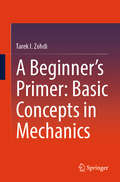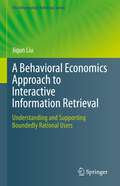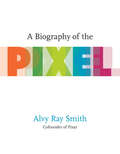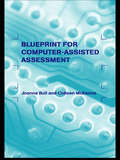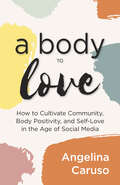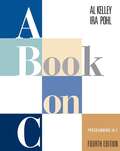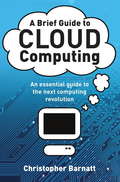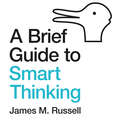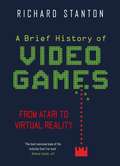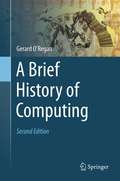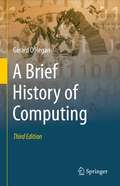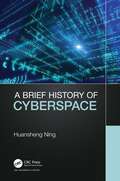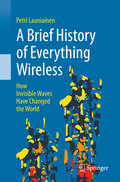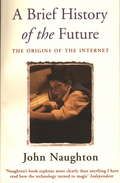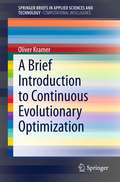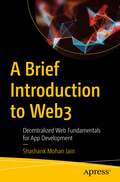- Table View
- List View
A Beginner’s Primer: Basic Concepts in Mechanics
by Tarek I. ZohdiAs we enter an exciting new era in industrial design, simulation, and manufacturing, a clear understanding of mechanics of solids is needed now more than ever. This primer is a condensed synopsis of basic undergraduate mechanics and is designed to supplement classical textbooks in this area. The focus is on the essentials of mechanics, specifically: • The concept of stress. • Stress-strain relationships. • Failure theory. • Axial loading of a rod. • Transverse (bending) loading of a beam. • Industrial application: modeling of 3D printing. • Transverse shear stresses. • Torsional loading of a rod. • Pressure vessels. • Buckling of columns. • The basics of finite element methods. • A unifying concept: continuum mechanics.
A Behavioral Economics Approach to Interactive Information Retrieval: Understanding and Supporting Boundedly Rational Users (The Information Retrieval Series #48)
by Jiqun LiuThis book brings together the insights from three different areas, Information Seeking and Retrieval, Cognitive Psychology, and Behavioral Economics, and shows how this new interdisciplinary approach can advance our knowledge about users interacting with diverse search systems, especially their seemingly irrational decisions and anomalies that could not be predicted by most normative models.The first part “Foundation” of this book introduces the general notions and fundamentals of this new approach, as well as the main concepts, terminology and theories. The second part “Beyond Rational Agents” describes the systematic biases and cognitive limits confirmed by behavioral experiments of varying types and explains in detail how they contradict the assumptions and predictions of formal models in information retrieval (IR). The third part “Toward A Behavioral Economics Approach” first synthesizes the findings from existing preliminary research on bounded rationality and behavioral economics modeling in information seeking, retrieval, and recommender system communities. Then, it discusses the implications, open questions and methodological challenges of applying the behavioral economics framework to different sub-areas of IR research and practices, such as modeling users and search sessions, developing unbiased learning to rank and adaptive recommendations algorithms, implementing bias-aware intelligent task support, as well as extending the conceptualization and evaluation on IR fairness, accountability, transparency and ethics (FATE) with the knowledge regarding both human biases and algorithmic biases.This book introduces a behavioral economics framework to IR scientists seeking a new perspective on both fundamental and new emerging problems of IR as well as the development and evaluation of bias-aware intelligent information systems. It is especially intended for researchers working on IR and human-information interaction who want to learn about the potential offered by behavioral economics in their own research areas.
A Billion Little Pieces: RFID and Infrastructures of Identification (Infrastructures)
by Jordan FrithHow RFID, a ubiquitous but often invisible mobile technology, identifies tens of billions of objects as they move through the world.RFID (Radio Frequency Identification) is ubiquitous but often invisible, a mobile technology used by more people more often than any flashy smartphone app. RFID systems use radio waves to communicate identifying information, transmitting data from a tag that carries data to a reader that accesses the data. RFID tags can be found in credit cards, passports, key fobs, car windshields, subway passes, consumer electronics, tunnel walls, and even human and animal bodies—identifying tens of billions of objects as they move through the world. In this book, Jordan Frith looks at RFID technology and its social impact, bringing into focus a technology that was designed not to be noticed.RFID, with its ability to collect unique information about almost any material object, has been hyped as the most important identification technology since the bar code, the linchpin of the Internet of Things—and also seen (by some evangelical Christians) as a harbinger of the end times. Frith views RFID as an infrastructure of identification that simultaneously functions as an infrastructure of communication. He uses RFID to examine such larger issues as big data, privacy, and surveillance, giving specificity to debates about societal trends. Frith describes how RFID can monitor hand washing in hospitals, change supply chain logistics, communicate wine vintages, and identify rescued pets. He offers an accessible explanation of the technology, looks at privacy concerns, and pushes back against alarmist accounts that exaggerate RFID's capabilities. The increasingly granular practices of identification enabled by RFID and other identification technologies, Frith argues, have become essential to the working of contemporary networks, reshaping the ways we use information.
A Biography of the Pixel (Leonardo)
by Alvy Ray SmithThe pixel as the organizing principle of all pictures, from cave paintings to Toy Story.The Great Digital Convergence of all media types into one universal digital medium occurred, with little fanfare, at the recent turn of the millennium. The bit became the universal medium, and the pixel--a particular packaging of bits--conquered the world. Henceforward, nearly every picture in the world would be composed of pixels--cell phone pictures, app interfaces, Mars Rover transmissions, book illustrations, videogames. In A Biography of the Pixel, Pixar cofounder Alvy Ray Smith argues that the pixel is the organizing principle of most modern media, and he presents a few simple but profound ideas that unify the dazzling varieties of digital image making. Smith's story of the pixel's development begins with Fourier waves, proceeds through Turing machines, and ends with the first digital movies from Pixar, DreamWorks, and Blue Sky. Today, almost all the pictures we encounter are digital--mediated by the pixel and irretrievably separated from their media; museums and kindergartens are two of the last outposts of the analog. Smith explains, engagingly and accessibly, how pictures composed of invisible stuff become visible--that is, how digital pixels convert to analog display elements. Taking the special case of digital movies to represent all of Digital Light (his term for pictures constructed of pixels), and drawing on his decades of work in the field, Smith approaches his subject from multiple angles--art, technology, entertainment, business, and history. A Biography of the Pixel is essential reading for anyone who has watched a video on a cell phone, played a videogame, or seen a movie.
A Blueprint for Computer-Assisted Assessment
by Joanna Bull Colleen McKennaThe rapid development and integration of computer-assisted assessment (CAA) in mainstream post-compulsory educational institutions today make this an exciting and invaluable reference text. It provides a practical, research-based guide on a subject that is becoming increasingly important as educational assessment changes and grows.The book addresses theory and practice, offering a comprehensive evaluation of many key aspects of CAA such as: * question and test design, scoring and analysis, and feedback and integration with other assessment methods* the role of CAA in feedback processes* wider use of technology to support and enhance assessment* technical, operational and support issues.The authors present a lucid,balanced analysis of the strengths and weaknesses of CAA. This text will appeal to all those involved in higher or further education who wish to model their CAA systems on the best practice available.
A Blueprint for Production-Ready Web Applications: Leverage industry best practices to create complete web apps with Python, TypeScript, and AWS
by Dr. Philip JonesGo from setting up your production environment, to building an app, to deploying it to the web using industry best practices along the wayKey FeaturesFollow a blueprint to build production-ready apps that can be adapted and tailored to your requirementsLearn how to combine a React frontend with a Quart backend, and run them in Docker on AWSAdopt industry best practices that can be used in your personal as well as work projectsBook DescriptionA Blueprint for Production-Ready Web Applications will help you expand upon your coding knowledge and teach you how to create a complete web application. Unlike other guides that focus solely on a singular technology or process, this book shows you how to combine different technologies and processes as needed to meet industry standards.You'll begin by learning how to set up your development environment, and use Quart and React to create the backend and frontend, respectively. This book then helps you get to grips with managing and validating accounts, structuring relational tables, and creating forms to manage data. As you progress through the chapters, you'll gain a comprehensive understanding of web application development by creating a to-do app, which can be used as a base for your future projects. Finally, you'll find out how to deploy and monitor your application, along with discovering advanced concepts such as managing database migrations and adding multifactor authentication.By the end of this web development book, you'll be able to apply the lessons and industry best practices that you've learned to both your personal and work projects, allowing you to further develop your coding portfolio.What you will learnSet up an optimum development environment for building web appsCreate a working backend Quart app that can be tailored to suit your needsBuild a user management system with passwords and authenticationBuild a single-page application with React Router and FormikDeploy your app to AWS and understand the importance of monitoringDiscover advanced concepts such as managing database migrationsWho this book is forThis book is for software engineers like recent computer science or bootcamp graduates who already know how to program and want to learn how to build an app by following standard industry processes such as continuous integration and continuous deployment (CI/CD). Working knowledge of TypeScript/JavaScript, Python, HTML, CSS, and SQL is needed. You don't, however, need prior experience with Quart, React, AWS, and all other specific technologies and processes, as they will be introduced in the book.
A Body to Love: How to Cultivate Community, Body Positivity, and Self-Love in the Age of Social Media
by Angelina CarusoHow to Have A Healthy Relationship with Food and Body Image in the Digital Age“Anyone who has ever had a ‘complicated’ relationship with food or their body will benefit from this book.” ?Brenna O’Malley, registered dietitian and founder of The Wellful#1 New Release in Human-Computer Interaction, Eating Disorder Self-Help, and Computer ScienceA new conversation about the media and radical self-love, A Body to Love provides lessons on positively navigating body image in a social media saturated world.Forming healthy relationships with the internet. To Angelina Caruso, recovery meant finding her tribe?a community that offered support, encouragement, and zero judgement. But she never imagined finding them online. Now a health and wellness blogger, she narrates the progression of a body image disorder and her unusual path to recovery.Self-help healing through community. Grouped into lessons and warnings, this fresh take on social networks follows the author’s personal battle with a near-fatal eating disorder, the online relationships that helped her heal, and the eventual community she cultivated. Part social media guide and part body image and eating disorder workbook, you’ll learn to detect body image issues, heal as a mindful consumer, and inspire others as a content producer.Inside this interactive book, adult and teen readers alike will find:Handy chartsJournal promptsBreathing exercisesBonus recipes for mindful eatingAnd much more!If you’re looking for a body positivity journal, body image gifts, or mindful eating books?like The Self-Love Workbook for Women, The Body Is Not an Apology, More Than a Body, or Influencer?then you’ll want to own A Body to Love.
A Book on C: Programming in C
by Al Kelley Ira PohlWritten by best-selling authors Al Kelley and Ira Pohl, A Book on C is a comprehensive tutorial and reference to C based on the ANSI C standard. The C language is demonstrated with numerous examples and extensive exercises that guide readers through each concept. Step-by-step "dissections" of program code reveal the underlying logic of the programs and include in-depth implementation details. Features in this edition include: a chapter on moving from C to Java; more programming examples; new and improved dissections; more thorough coverage of multifile programming, pointers, and recursion; and an expanded appendix of standard library functions. In addition, there is more emphasis on Abstract Data Types, which provides the reader with a foundation for working with objects and facilitates programming in the problem domain.
A Brain-Inspired Approach to Natural Language Processing (Studies in Computational Intelligence #1225)
by Herwig Unger Thasayu SoisoonthornThis book brings together key ideas from neuroscience and artificial intelligence to show how they can work together. It helps readers understand how studying the brain can lead to more adaptable and efficient AI systems. Instead of treating the two fields as separate, it highlights how brain-inspired models can help overcome current challenges in AI, improve existing techniques, and spark new and creative solutions.The journey begins with the biological foundations of intelligence, focusing on the brain&’s structure, evolution, and functions, particularly the neocortex, which plays a central role in learning and prediction. Building on this foundation, the book surveys both traditional and modern AI methods in an accessible way and offers a critical analysis of their strengths and shortcomings. The discussion then moves from theory to practice, showing how brain-inspired ideas can be applied to real-world Natural Language Processing (NLP) tasks such as spelling correction and Thai word segmentation, where conventional models often struggle with nuance and complexity. In its final sections, the book reflects on the broader significance of integrating neuroscience and AI, encouraging continued exploration and innovation at the intersection of these disciplines. Key benefits of this book include: - Exploring biologically plausible models of intelligence to open new pathways- Gaining foundational insights into how neuroscience can inform AI design- Presenting practical examples to enhance NLP tasks in complex languages- Offering a testbed for experimentation with brain-inspired computational models- Serving as a valuable resource for advanced students, researchers, and professionals seeking to deepen their understanding of nature-inspired intelligent systems While refining existing AI models may lead to meaningful progress, it remains uncertain whether such approaches alone can achieve a deeper form of intelligence. By contrast, drawing inspiration from the structure and function of the human brain may offer a promising direction toward creating systems that are more flexible, adaptive, and capable of exhibiting human-like behavior.
A Brief Guide to Cloud Computing: An essential guide to the next computing revolution. (Brief Histories)
by Christopher BarnattAn accessible and comprehensive guide to the future of computing.Cloud Computing is the next computing revolution and will have as much impact on your life as the introduction of the PC. Using websites including Facebook, Flickr and Gmail, many people already store some information out in the Internet cloud. However, within a few years most computing applications will be accessed online with the web at the heart of everything we do.In this valuable guide, expert Christopher Barnatt explains how computing will rapidly become more reliable, less complex, and more environmentally friendly. He explores online software and hardware, and how it will alter our office work and personal lives. Individuals and companies are going to be released from the constraints of desktop computing and expensive corporate data centres. New services like augmented reality will also become available.Including coverage of Google Docs, Zoho, Microsoft Azure, Amazon EC2 and other key developments, this book is your essential guide to the cloud computing revolution.
A Brief Guide to Smart Thinking: From Zeno's Paradoxes to Freakonomics
by James M. RussellEach book is summarised to convey a brief idea of what each one has to offer the interested reader, while a 'Speed Read' for each book delivers a quick sense of what each book is like to read and a highly compressed summary of the main points of the book in question. The titles covered include thought-provoking classics on psychology, mindfulness, rationality, the brain, mathematical and economic thought and practical philosophy. The selection includes books about self-improvement as well as historically interesting accounts of how the mind works. Titles included go back as far as the Epictetus classic TheEnchiridion and Bertrand Russell's charming TheABC of Relativity, and proceed through classics such as Edward de Bono's Lateral Thinking and into the digital era with titles such as The Shallows and Big Data. The books are arranged chronologically, which draws attention to some of the interesting juxtapositions and connections between them. Some of the titles included are: Freakonomics, by Steven D. Levitt; Blink: The Power of Thinking Without Thinking, by Malcolm Gladwell; Sapiens: A Brief History of Humankind, by Yuval Noah Harari; The Organized Mind: Thinking Straight in the Age of Information Overload, by Daniel J. Levitin; The Descent of Man, by Grayson Perry; How the Mind Works, by Steven Pinker; Black Box Thinking: Why Some People Never Learn from Their Mistakes - But Some Do, by Matthew Syed; We Should All Be Feminists, by Chimamanda Ngozi Adichie; Guns, Germs, and Steel: The Fates of Human Societies, by Jared Diamond; The Black Swan: The Impact of the Highly Improbable, by Nassim Nicholas Taleb; Man's Search for Meaning, by Viktor E. Frankl; The News: A User's Manual, by Alain de Botton; Mindware: Tools for Smart Thinking, by Richard E. Nisbett; The ABC of Relativity, by Bertrand Russell; The Psychopath Test, by Jon Ronson; The Path: What Chinese Philosophers Can Teach Us About the Good Life, by Michael Puett; A Brief History of Time, by Stephen Hawking; Messy: The Power of Disorder to Transform Our Lives, by Tim Harford; Big Data: A Revolution That Will Transform How We Live, Work, and Think, by Viktor Mayer-Schönberger; Moneyball: The Art of Winning an Unfair Game, by Michael Lewis; The Survivors Club: The Secrets and Science That Could Save Your Life, by Ben Sherwood; Black Box Thinking, by Matthew Syed; Chaos: Making a New Science, by James Gleick; A Short History of Nearly Everything, by Bill Bryson; The Shallows: What the Internet Is Doing to Our Brains, by Nicholas Carr; Making Ideas Happen: Overcoming the Obstacles Between Vision and Reality, by Scott Belsky; The Enchiridion, by Epictetus; Gödel, Escher, Bach, by Douglas R. Hofstadter; What I Talk About When I Talk About Running, by Haruki Murakami; and Lateral Thinking, by Edward de Bono.
A Brief Guide to Smart Thinking: From Zeno's Paradoxes to Freakonomics
by James M. RussellEach book is summarised to convey a brief idea of what each one has to offer the interested reader, while a 'Speed Read' for each book delivers a quick sense of what each book is like to read and a highly compressed summary of the main points of the book in question. The titles covered include thought-provoking classics on psychology, mindfulness, rationality, the brain, mathematical and economic thought and practical philosophy. The selection includes books about self-improvement as well as historically interesting accounts of how the mind works. Titles included go back as far as the Epictetus classic The Enchiridion and Bertrand Russell's charming The ABC of Relativity, and proceed through classics such as Edward de Bono's Lateral Thinking and into the digital era with titles such as The Shallows and Big Data. The books are arranged chronologically, which draws attention to some of the interesting juxtapositions and connections between them. Some of the titles included are: Freakonomics, by Steven D. Levitt; Blink: The Power of Thinking Without Thinking, by Malcolm Gladwell; Sapiens: A Brief History of Humankind, by Yuval Noah Harari; The Organized Mind: Thinking Straight in the Age of Information Overload, by Daniel J. Levitin; The Descent of Man, by Grayson Perry; How the Mind Works, by Steven Pinker; Black Box Thinking: Why Some People Never Learn from Their Mistakes - But Some Do, by Matthew Syed; We Should All Be Feminists, by Chimamanda Ngozi Adichie; Guns, Germs, and Steel: The Fates of Human Societies, by Jared Diamond; The Black Swan: The Impact of the Highly Improbable, by Nassim Nicholas Taleb; Man's Search for Meaning, by Viktor E. Frankl; The News: A User's Manual, by Alain de Botton; Mindware: Tools for Smart Thinking, by Richard E. Nisbett; The ABC of Relativity, by Bertrand Russell; The Psychopath Test, by Jon Ronson; The Path: What Chinese Philosophers Can Teach Us About the Good Life, by Michael Puett; A Brief History of Time, by Stephen Hawking; Messy: The Power of Disorder to Transform Our Lives, by Tim Harford; Big Data: A Revolution That Will Transform How We Live, Work, and Think, by Viktor Mayer-Schönberger; Moneyball: The Art of Winning an Unfair Game, by Michael Lewis; The Survivors Club: The Secrets and Science That Could Save Your Life, by Ben Sherwood; Black Box Thinking, by Matthew Syed; Chaos: Making a New Science, by James Gleick; A Short History of Nearly Everything, by Bill Bryson; The Shallows: What the Internet Is Doing to Our Brains, by Nicholas Carr; Making Ideas Happen: Overcoming the Obstacles Between Vision and Reality, by Scott Belsky; The Enchiridion, by Epictetus; Gödel, Escher, Bach, by Douglas R. Hofstadter; What I Talk About When I Talk About Running, by Haruki Murakami; and Lateral Thinking, by Edward de Bono.
A Brief Guide to Smart Thinking: From Zeno’s Paradoxes to Freakonomics
by James M. RussellEach book is summarised to convey a brief idea of what each one has to offer the interested reader, while a 'Speed Read' for each book delivers a quick sense of what each book is like to read and a highly compressed summary of the main points of the book in question. The titles covered include thought-provoking classics on psychology, mindfulness, rationality, the brain, mathematical and economic thought and practical philosophy. The selection includes books about self-improvement as well as historically interesting accounts of how the mind works. Titles included go back as far as the Epictetus classic The Enchiridion and Bertrand Russell's charming The ABC of Relativity, and proceed through classics such as Edward de Bono's Lateral Thinking and into the digital era with titles such as The Shallows and Big Data. The books are arranged chronologically, which draws attention to some of the interesting juxtapositions and connections between them. Some of the titles included are: Freakonomics, by Steven D. Levitt; Blink: The Power of Thinking Without Thinking, by Malcolm Gladwell; Sapiens: A Brief History of Humankind, by Yuval Noah Harari; The Organized Mind: Thinking Straight in the Age of Information Overload, by Daniel J. Levitin; The Descent of Man, by Grayson Perry; How the Mind Works, by Steven Pinker; Black Box Thinking: Why Some People Never Learn from Their Mistakes - But Some Do, by Matthew Syed; We Should All Be Feminists, by Chimamanda Ngozi Adichie; Guns, Germs, and Steel: The Fates of Human Societies, by Jared Diamond; The Black Swan: The Impact of the Highly Improbable, by Nassim Nicholas Taleb; Man's Search for Meaning, by Viktor E. Frankl; The News: A User's Manual, by Alain de Botton; Mindware: Tools for Smart Thinking, by Richard E. Nisbett; The ABC of Relativity, by Bertrand Russell; The Psychopath Test, by Jon Ronson; The Path: What Chinese Philosophers Can Teach Us About the Good Life, by Michael Puett; A Brief History of Time, by Stephen Hawking; Messy: The Power of Disorder to Transform Our Lives, by Tim Harford; Big Data: A Revolution That Will Transform How We Live, Work, and Think, by Viktor Mayer-Schönberger; Moneyball: The Art of Winning an Unfair Game, by Michael Lewis; The Survivors Club: The Secrets and Science That Could Save Your Life, by Ben Sherwood; Black Box Thinking, by Matthew Syed; Chaos: Making a New Science, by James Gleick; A Short History of Nearly Everything, by Bill Bryson; The Shallows: What the Internet Is Doing to Our Brains, by Nicholas Carr; Making Ideas Happen: Overcoming the Obstacles Between Vision and Reality, by Scott Belsky; The Enchiridion, by Epictetus; Gödel, Escher, Bach, by Douglas R. Hofstadter; What I Talk About When I Talk About Running, by Haruki Murakami; and Lateral Thinking, by Edward de Bono.
A Brief History Of Video Games: From Atari to Virtual Reality (Brief Histories)
by Rich Stanton'Stanton writes with terrific verve and precision . . . his understanding of the seductive pleasures of gaming takes us right to its heart.'Maria Bustillos, Times Literary Supplement'The best overview book of the industry that I've read.'Andrew Liptak, io9From the first wood-panelled Pong machines in California to the masterpieces of engineering that now sit in countless homes all over the world, A Brief History of Video Games reveals the vibrant history and culture of interactive entertainment. Above all, this is a book about the games - how the experience of playing has developed from simple, repetitive beginnings into a cornucopia of genres and styles, at once utterly immersive and socially engaging. With full-colour illustrations throughout, it shows how technological advances have transformed the first dots and dashes of bored engineers into sophisticated, responsive worlds that are endlessly captivating. As thrilling and surprising as the games it describes, this is an indispensable read for anyone serious about the business of having fun.
A Brief History of Artificial Intelligence: What It Is, Where We Are, and Where We Are Going
by Michael WooldridgeFrom Oxford's leading AI researcher comes a fun and accessible tour through the history and future of one of the most cutting edge and misunderstood field in science: Artificial IntelligenceThe somewhat ill-defined long-term aim of AI is to build machines that are conscious, self-aware, and sentient; machines capable of the kind of intelligent autonomous action that currently only people are capable of. As an AI researcher with 25 years of experience, professor Mike Wooldridge has learned to be obsessively cautious about such claims, while still promoting an intense optimism about the future of the field. There have been genuine scientific breakthroughs that have made AI systems possible in the past decade that the founders of the field would have hailed as miraculous. Driverless cars and automated translation tools are just two examples of AI technologies that have become a practical, everyday reality in the past few years, and which will have a huge impact on our world.While the dream of conscious machines remains, Professor Wooldridge believes, a distant prospect, the floodgates for AI have opened. Wooldridge's A Brief History of Artificial Intelligence is an exciting romp through the history of this groundbreaking field--a one-stop-shop for AI's past, present, and world-changing future.
A Brief History of Computing
by Gerard O'ReganThis lively and fascinating text traces the key developments in computation - from 3000 B.C. to the present day - in an easy-to-follow and concise manner. Topics and features: ideal for self-study, offering many pedagogical features such as chapter-opening key topics, chapter introductions and summaries, exercises, and a glossary; presents detailed information on major figures in computing, such as Boole, Babbage, Shannon, Turing, Zuse and Von Neumann; reviews the history of software engineering and of programming languages, including syntax and semantics; discusses the progress of artificial intelligence, with extension to such key disciplines as philosophy, psychology, linguistics, neural networks and cybernetics; examines the impact on society of the introduction of the personal computer, the World Wide Web, and the development of mobile phone technology; follows the evolution of a number of major technology companies, including IBM, Microsoft and Apple.
A Brief History of Computing
by Gerard O'ReganThis lively and fascinating text traces the key developments in computation – from 3000 B.C. to the present day – in an easy-to-follow and concise manner. Topics and features: ideal for self-study, offering many pedagogical features such as chapter-opening key topics, chapter introductions and summaries, exercises, and a glossary; presents detailed information on major figures in computing, such as Boole, Babbage, Shannon, Turing, Zuse and Von Neumann; discusses the earliest computers developed in the United States, Germany and Britain; discusses the development of the IBM 360 family of computers and its importance; discusses the invention of the transistor and integrated circuit; discusses the birth of the software industry and the evolution of human-computer interaction; reviews the history of programming languages, operating systems and software engineering; discusses the progress of artificial intelligence; discusses the invention of the microprocessor and the development of home and personal computers; examines the impact on society of the introduction of the personal computer, the World Wide Web, and the development of mobile phone technology; discusses smart phones and social media and the challenge of fake news; reviews a miscellany of innovations in the computing field such as cloud computing, the Internet of Things, and Quantum Computing; discusses legal aspects of computing and the professional responsibilities of computer professionals.
A Brief History of Cryptology and Cryptographic Algorithms (SpringerBriefs in Computer Science)
by John F. DooleyThe science of cryptology is made up of two halves. Cryptography is the study of how to create secure systems for communications. Cryptanalysis is the study of how to break those systems. The conflict between these two halves of cryptology is the story of secret writing. For over 2,000 years, the desire to communicate securely and secretly has resulted in the creation of numerous and increasingly complicated systems to protect one's messages. Yet for every system there is a cryptanalyst creating a new technique to break that system. With the advent of computers the cryptographer seems to finally have the upper hand. New mathematically based cryptographic algorithms that use computers for encryption and decryption are so secure that brute-force techniques seem to be the only way to break them - so far. This work traces the history of the conflict between cryptographer and cryptanalyst, explores in some depth the algorithms created to protect messages, and suggests where the field is going in the future.
A Brief History of Cyberspace
by Huansheng NingWith the widespread growth of the Internet, a new space – cyberspace – has appeared and has rapidly been integrated into every facet of life and work. It has effectively become the fourth basic living space for human beings. Although cyberspace has become a topic of increasing widespread concern, it is still difficult to understand cyberspace well because of its many definitions, vast and varied content, and differences with other similar spaces. A Brief History of Cyberspace attempts to establish a complete knowledge system about the evolution and history of cyberspace and cyber-enabled spaces (i.e., cyber-enabled physical space, cyber-enabled social space, and cyber-enabled thinking space). By providing a comprehensive overview, this book aims to help readers understand the history of cyberspace and lays a solid foundation for researchers and learners who are interested in cyberspace. The book has three main objectives: To provide a comprehensive understanding of the development of cyberspace, ranging from its origin, evolutions, and research status to open issues and future challenges, as well as related hot topics in industry and academia. To examine cyber life, cyber syndrome, and health in addition to cyber-enabled spaces designed for better living. To describe cyberspace governance from the perspective of the individual, society, and national and international levels in order to promote a more profound and reasonable direction to the development of cyberspace. Consisting of 16 chapters, the book is divided into three parts. Chapter 1 introduces the origins and basic concept of cyberspace, cyber philosophy, and cyber logic to help readers have a general understanding of cyberspace. Chapters 2 through 7 discuss a wide variety of topics related to human behavior, psychology, and health to help people better adapt to cyberspace. Chapters 8 through 16 present the history of cyberspace governance and various social and culture aspects of cyberspace. Each chapter concludes with a discussion of future development.
A Brief History of Everything Wireless: How Invisible Waves Have Changed the World
by Petri LauniainenSince the discovery of electromagnetic waves less than 150 years ago, the application of wireless communications technology has not only revolutionized our daily lives, but also fundamentally changed the course of world history.A Brief History of Everything Wireless charts the fascinating story of wireless communications. The book leads the reader on an intriguing journey of personal triumphs and stinging defeats, relating the prominent events, individuals and companies involved in each progressive leap in technology, with a particular focus on the phenomenal impact of each new invention on society. Beginning at the early days of spark-gap transmitters, this tale touches on the emergence of radio and television broadcasting, as well as radio navigation and radar, before moving on to the rise of satellite, near-field and light-based communications. Finally, the development of wireless home networks and the explosive growth of modern cellular technologies are revealed, complete with a captivating account of their corresponding company histories and behind-the-scenes battles over standards.For those wishing to peek behind the magic curtain of friendly user interfaces and clever engineering, and delve further into various processes underlying the ubiquitous technology we depend upon yet take for granted, the book also contains special “TechTalk” chapters that explain the theoretical basics in an intuitive way.
A Brief History of Intelligence: From the Big Bang to the Metaverse
by F. Richard Yu Angela W. YuThis book introduces a variety of intelligence phenomena starting from the birth of the universe, including intelligence in physics, intelligence in chemistry, intelligence in biology, intelligence in humans and intelligence in machines. It uncovers the mystery of intelligence to the world and explores the natural phenomenon of intelligence. If understanding intelligence is regarded as a journey of a thousand miles, then this book is the first step to try. In the process of studying the phenomenon of intelligence and the nature of intelligence, our eyes cannot be limited to human intelligence. Instead, one should put our vision beyond human intelligence, consider different things in the universe, reach a new level, and study and explore the phenomenon of intelligence and the essence of intelligence on a new level.By looking at the various phenomena of intelligence since the birth of the universe, readers can see that intelligence is a natural phenomenon, similar to other natural phenomena (e.g., the rolling of rocks and the melting of snow and ice). These phenomena occur to facilitate the stability of the universe, and the phenomenon of intelligence is no exception. The book is divided into 10 chapters, covering matter, energy and space in the origin of the universe, gravity in physics, the principle of least action, dissipative structures in chemistry, entropy increase, maximum entropy production, the definition of life, the emergence of life, the intelligence in plants, the intelligence in animals, the neocortex structure of the brain, the special thinking of human beings, the theory of the brain, artificial intelligence symbolism, connectionism, behaviorism, artificial general intelligence, metaverse, etc.This book can be used as a reference for students and researchers working in the artificial intelligence areas. It is also positioned as a popular science book interested in intelligent phenomena.
A Brief History of Video Games
by Richard StantonThis Brief History provides a unique look at the history and culture of video games, starting with the 1960s classics like Pong to modern favorites such as Grand Theft Auto V and Bioshock. Focusing on creative and scientific advances between 1962 and today, A Brief History of Video Games offers a global perspective on gaming's past and its cutting-edge future with the evolution of virtual reality, 3D graphics, and thought-interface technology. It also addresses the design process from concept to packaging, considers the influence of manga and anime, and explores the relationship between video games and movies.
A Brief History of the Future
by John NaughtonThe Internet is the most remarkable thing human beings have built since the Pyramids. John Naughton's book intersperses wonderful personal stories with an authoritative account of where the Net actually came from, who invented it and why and where it might be taking us. Most of us have no idea how the Internet works, or who created it. Even fewer have any idea what it means for society and the future. In a cynical age, John Naughton has not lost his capacity for wonder. He examines the nature of his own enthusiasm for technology and traces its roots in his lonely childhood and in his relationship with his father. A Brief History of the Future is an intensely personal celebration of vision and altruism, ingenuity and determination and, above all, of the power of ideas, passionately felt, to change the world.
A Brief Introduction to Continuous Evolutionary Optimization (SpringerBriefs in Applied Sciences and Technology)
by Oliver KramerPractical optimization problems are often hard to solve, in particular when they are black boxes and no further information about the problem is available except via function evaluations. This work introduces a collection of heuristics and algorithms for black box optimization with evolutionary algorithms in continuous solution spaces. The book gives an introduction to evolution strategies and parameter control. Heuristic extensions are presented that allow optimization in constrained, multimodal and multi-objective solution spaces. An adaptive penalty function is introduced for constrained optimization. Meta-models reduce the number of fitness and constraint function calls in expensive optimization problems. The hybridization of evolution strategies with local search allows fast optimization in solution spaces with many local optima. A selection operator based on reference lines in objective space is introduced to optimize multiple conflictive objectives. Evolutionary search is employed for learning kernel parameters of the Nadaraya-Watson estimator and a swarm-based iterative approach is presented for optimizing latent points in dimensionality reduction problems. Experiments on typical benchmark problems as well as numerous figures and diagrams illustrate the behavior of the introduced concepts and methods.
A Brief Introduction to Web3: Decentralized Web Fundamentals for App Development
by Shashank Mohan JainJourney into the world of Web3-based application development, its related protocols, and its usage in developing decentralized applications. This book will explain how programmable blockchains are revolutionizing the world of web applications, which can be run on decentralized platforms or peer-to-peer networks like IPFS.You'll start with an introduction to decentralization with a focus on blockchain implementations like Ethereum and Bitcoin. You'll then learn to develop simple decentralized applications (dApps) using Solidity, the language used for developing apps with Ethereum as well as smart contracts, wallets, gateways and NFTs. This book also covers how security and scale are addressed by L2 networks for scaling Bitcoin and Ethereum blockchains. A Brief Introduction to Web3 is your go-to guide for setting up simple Web3 applications using the Ethereum blockchain programming model.What You Will Learn Build NFT tokensExamine Web3 differs from Web2-based applicationsUnderstand the fundamentals of blockchain and the corresponding data structures around itSee how consensus and trustless computing can be performed using blockchain Use Solidity and Truffle to build Web3 applications Who This Book Is For Software developers and architects who are looking to hone their skills in dApps and web3 applications developed on sound principles of decentralized computing.
